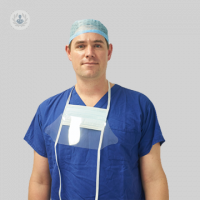Foot and ankle arthritis: What does it feel like?
Escrito por:Arthritis is the inflammation or swelling of one or more joints and their connective tissue. Although it commonly involves the hands, knees or hips, any of the 33 joints in the foot and ankle can also be affected.
Here to provide a detailed insight into foot and ankle arthritis, including causes, diagnosis and treatment, is Mr Edward Dawe, expert orthopaedic surgeon.

What does foot and ankle arthritis feel like?
Most patients start to notice arthritis as a pain in their foot or ankle. The pain is often worst first thing in the morning and tends to ease off with activity. Due to the numerous joints within the foot and ankle, the pain may be commonly located at the big toe joint, in the midfoot, or higher up the leg towards the ankle.
Arthritis also causes stiffness in the affected joints which patients may notice during certain activities. One example is of patients with subtalar joint arthritis (the joint underneath the ankle that allows side-to-side movement of the foot), who tend to notice their symptoms when walking on uneven ground.
What causes foot and ankle arthritis?
Most cases of foot and ankle arthritis are idiopathic, meaning that no cause for the arthritis is found. The ankle joint is very susceptible to arthritis and in fact, the condition often develops after an injury (called post-traumatic arthritis).
In some patients, arthritis develops as a result of an inflammatory disease, such as with rheumatoid arthritis or psoriatic arthritis. However, overall, this is a small proportion of patients.
One final group of patients who develop arthritis are those with a biomechanical abnormality in the shape of their foot which overloads a joint, causing arthritis. One example of this are patients with a long first metatarsal, who are particularly prone to big toe arthritis.
How is foot and ankle arthritis diagnosed?
Diagnosis of foot and ankle arthritis is usually a combination of an examination by a foot and ankle surgeon, and X-rays to confirm the diagnosis. Where there are several joints affected or the arthritis is early, another type of scan, such as an MRI scan or a standing CT scan, could be needed. Where doubt still exists about the exact joint causing pain, patients could need an injection into the joint to look at how effective further treatment of that joint is likely to be.
When is treatment required?
Arthritis in the foot and ankle is a safe condition which some patients tolerate extremely well in the long term. There is no absolute need for intervention.
Joints in the foot and ankle which are affected by arthritis respond differently to the different types of splints and bracing available for treatment. These can be very helpful in managing symptoms without surgery.
Steroid injections are effective in a proportion of patients, and often form part of the first-line treatment for arthritis.
When other measures fail, patients may need to consider surgery. There are numerous different surgeries for arthritis in the foot and ankle, such as ankle replacement and fusion surgeries (where bones at either side of an arthritic joint are joined with surgery to eradicate pain). Sometimes, it is possible to perform surgeries with a shorter recovery, such as a cheilectomy (removal of bone), which can be very effective.
Modern foot and ankle arthritis surgery has significantly advanced to such an extent that most surgeries can be carried out as a day-case procedure and allow early (two weeks) or immediate weight-bearing. Patients with arthritis in the forefoot can expect to completely avoid a plaster cast after surgery. Following fusion surgery in other areas in the foot and ankle, a plaster is generally only needed for up to six weeks. Patients are usually able to walk on the foot wrapped in plaster from two weeks after surgery.
These techniques for achieving better pain relief after surgery have reduced the discomfort experienced by most patients.
Sometimes, when discussing fusions in the foot and ankle for arthritis, patients are concerned that their foot or ankle will not move. Usually, this is not the case. This is because most fusion operations are selective procedures, meaning that only one or two joints are fused and all the other joints in the foot and ankle continue to move. Inevitably, there will be some stiffness after a fusion, but this is the (generally) good pain relief achieved by these procedures.
Can lifestyle measures improve the symptoms of foot and ankle arthritis?
Yes. The biggest factor affecting how much pain patients have from foot arthritis is their weight. Thus, even a moderate amount of weight loss can improve symptoms. In addition to this, losing weight is helpful for the preparation for surgery and the recovery time after.
Exercise is another important factor that can help to manage the symptoms from arthritis. Once patients have a diagnosis, they should try to keep the affected joint moving. Gentle exercise, such as cycling and walking, is important and can considerably improve symptoms.
Mr Dawe is a skilled orthopaedic surgeon who specialises exclusively in foot and ankle problems. If you are concerned about foot and ankle arthritis and wish to seek expert treatment and management, do not hesitate to visit Mr Dawe’s Top Doctors profile today.


